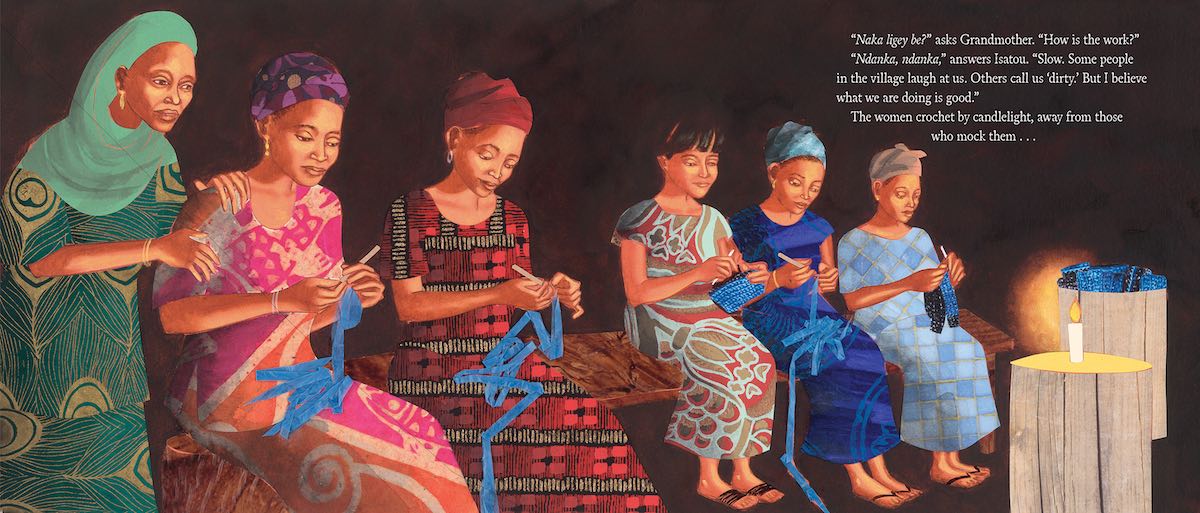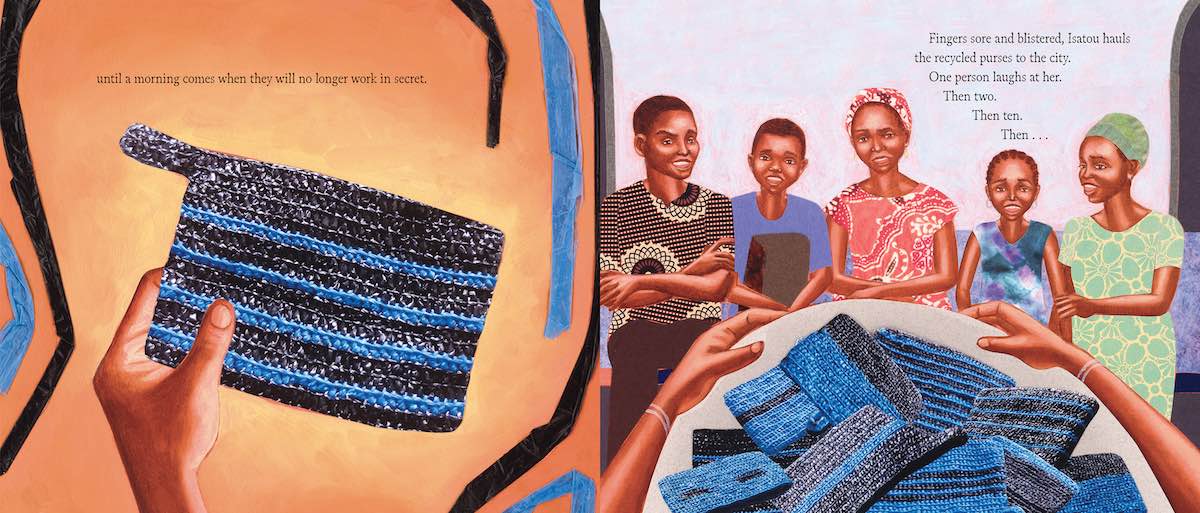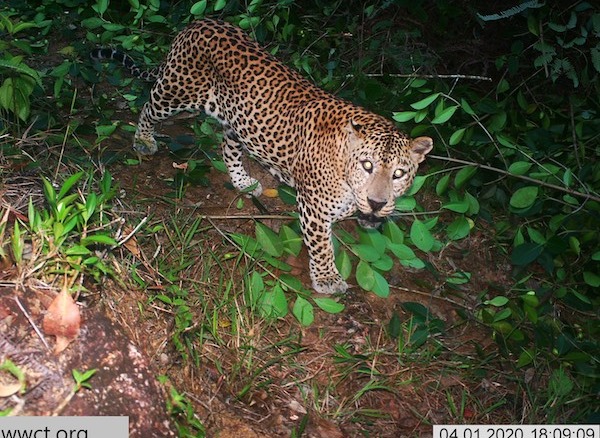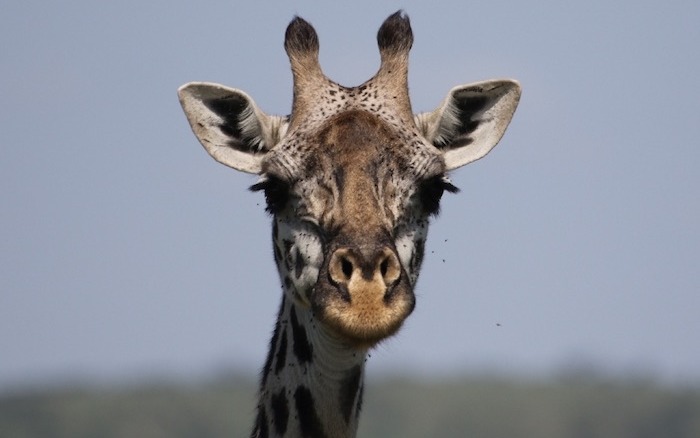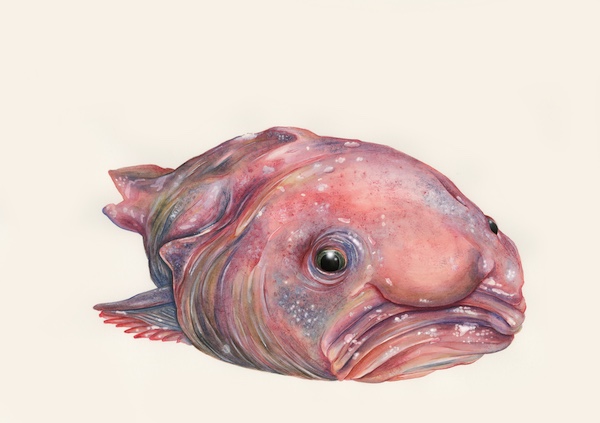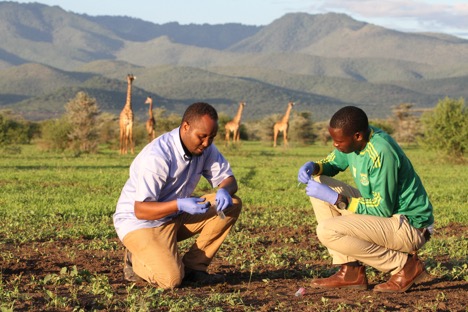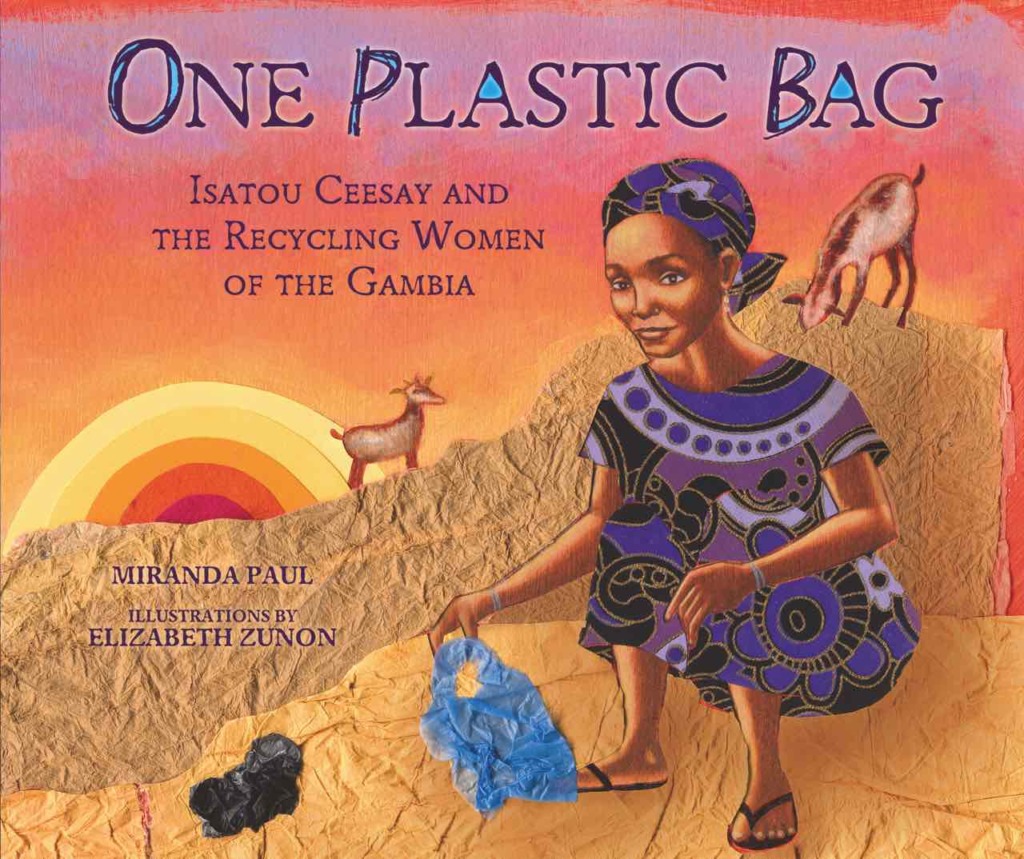
Book synopsis: The inspiring true story of how one African woman, Isatou Ceesay, began a movement to recycle the plastic bags that were polluting her community.
Published by Lerner Publishing, with beautiful illustrations by Elizabeth Zunon.
We talk with:
Author
Miranda Paul
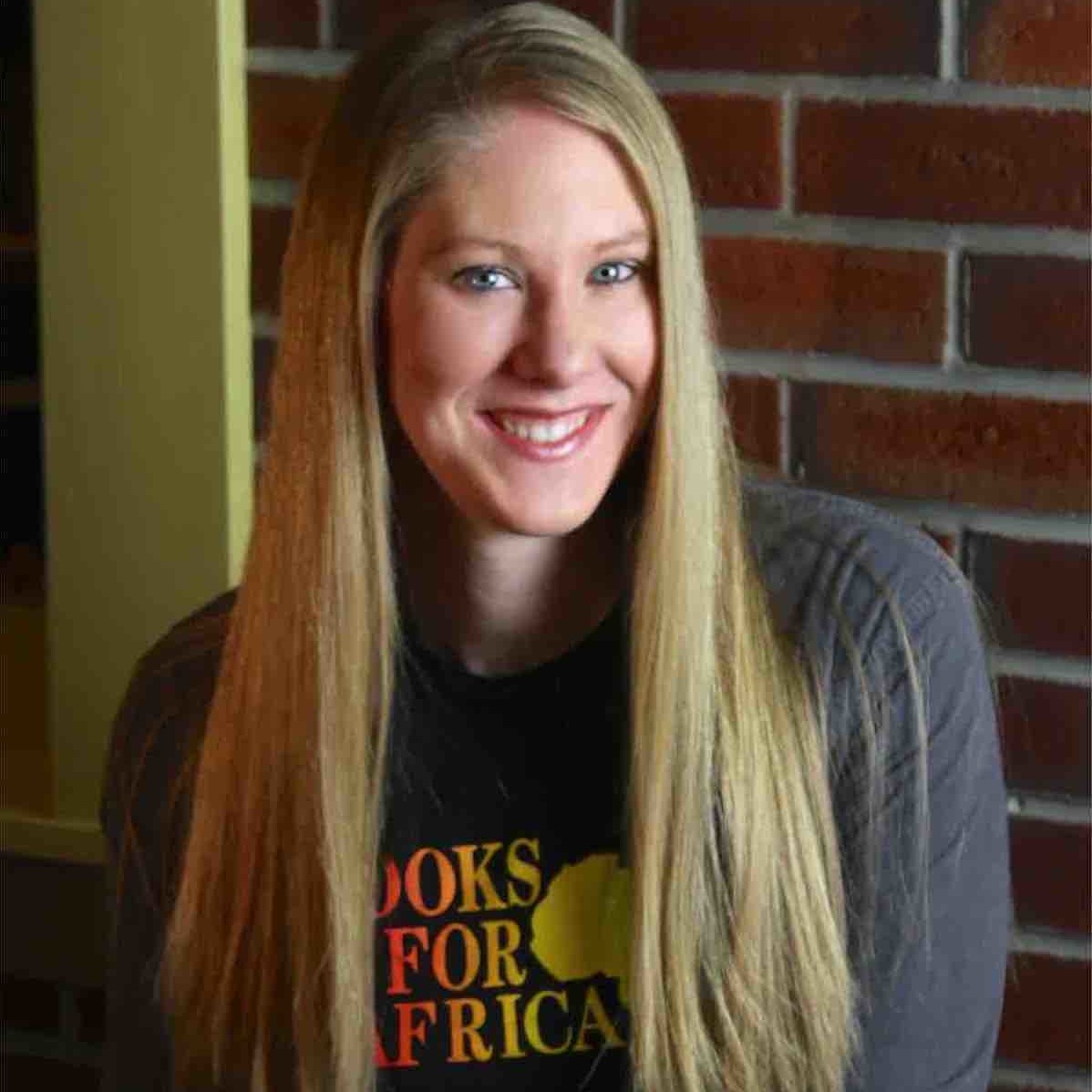
Activist
Isatou Ceesay
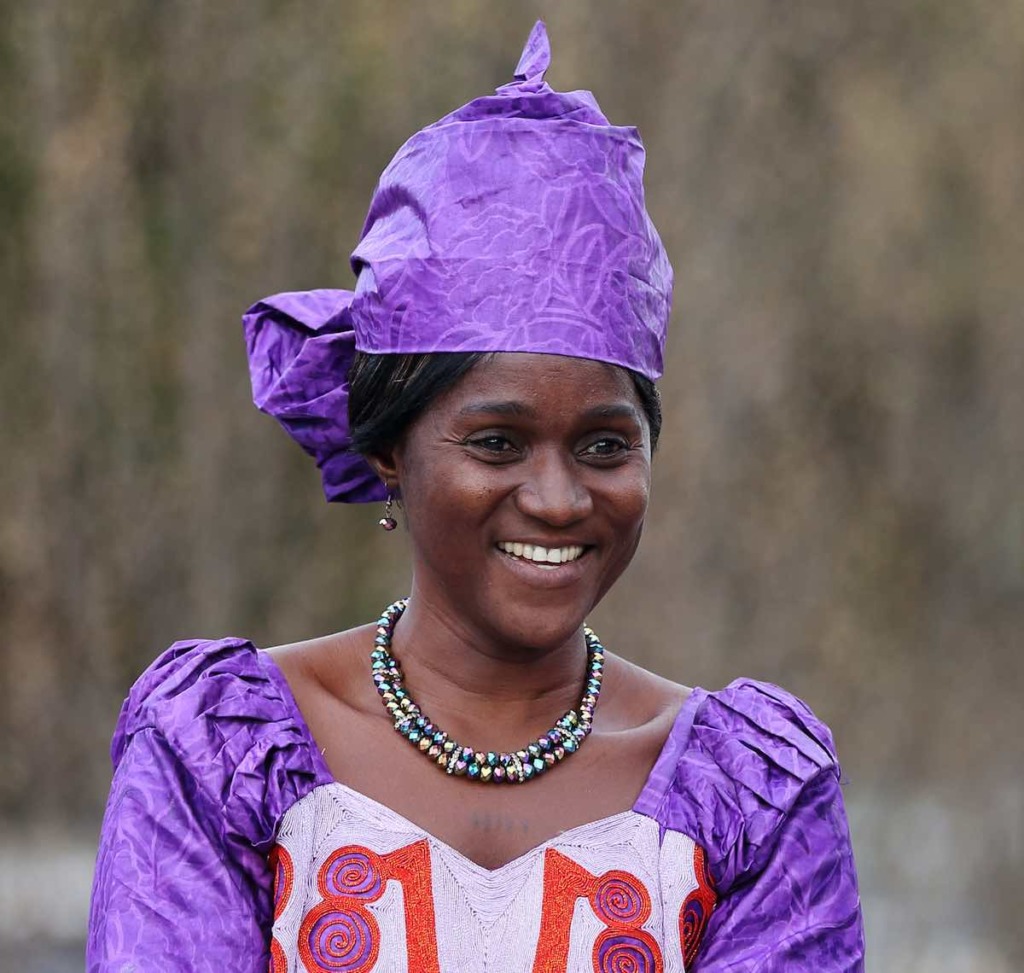
Miranda Paul is an award-winning author of more than a dozen fiction and nonfiction books for children. Miranda is a frequent presenter at schools and is a co-founding member of We Need Diverse Books.
Isatou Ceesay is an environmental activist and entrepreneur who formed Njau Recycling and Income Generating Group to help tackle plastic pollution in her community and in other parts of The Gambia.
Miranda and Isatou have presented together at the Library of Congress Young Readers Center.
Interview with Miranda:
Mongabay Kids: How did you learn about Isatou’s work on reusing plastic bags? And what about her work inspired you to write her story?
Miranda: I was working in The Gambia as a teacher, and another teacher (a Peace Corps volunteer) showed me one of the purses. I was so glad to see someone in the country was finding a solution to the plastic bag problem that seemed to plague every village and city.
Her work inspired me because it was so high quality, but very sustainably produced and grassroots.
But her story also inspired me because in the early 2000s especially I began to see what a problem plastic was becoming all over the world, and knew we needed more stories of difference makers and change.
Mongabay Kids: What was the process of writing One Plastic Bag like? How did you do your research and how long did it take to complete the book?
Miranda: From the time I was handed that recycled plastic bag purse until the book came out was a twelve-year span of my life!
I’ve traveled to The Gambia five times, three of which were specifically spent with Isatou and the women of Njau.
I conducted interviews with the women in person, but also over other forms of communication in between trips. I took a video camera, notebook, and felt like Isatou’s shadow for long stretches of time.
We’ve come to know each other quite well. I wrote about 31 total drafts or revisions of the story.
Mongabay Kids: If a young person has an environmental issue or an inspiring person that they want to write a story about, what is your advice on how to get started?
Miranda: Don’t be afraid to reach out to that person and ask for an interview! Being with them (or people who know them) can inform your story in an emotional way, giving you insight that reading articles about a person wouldn’t.
Isatou and I have become lifelong friends because of my interest in finding out more about her project, and being one of the first people to write about her.
Another tip would be that you’re going to find out WAY more information than what will fit in your book or report, and to know that’s normal.
Find a lot of facts and then look at them to see which ones are the strongest or fit together and use those to tell your story.
Preview of the book:
Mongabay Kids: What would you most like readers of One Plastic Bag to take with them from learning Isatou Ceesay’s story?
Miranda: One person can make a difference — especially when we don’t linger on (or ignore) the problem, but actively work toward solutions. Your choices make an impact, so make good ones when you can.
teacher resources
Click the button to visit Miranda's webpage for teacher resources to go with the book. Then, scroll down or search "One Plastic Bag."
Interview with Isatou:
Mongabay Kids: What was the plastic bag pollution problem like in your community before you had the idea to recycle the bags into products like purses?
Isatou: Before I started this work, everywhere you would find plastic bags flying all over the environment.
The women, in those days, they were using the bags to light fires when they wanted to cook, especially during the rainy season when all of our firewood was wet.
The plastic was flying everywhere. What normally people did was just to burn the plastic bags to be able to get rid of the pollution. Otherwise, our animals, they will come across the bags and they will eat them. And when they eat them they will die and then we would lose a lot of income out of that.
The other problem from plastic bag pollution is that when the rain starts, water will stay on the plastic and then the mosquitoes will lay eggs on it. At night they will come and bite us and then we can get malaria. And malaria kills a lot of people around here. So it was like that before I started this work.
Mongabay Kids: Do you feel like plastic pollution is still a problem in your community? Or have you been able to remove most of the plastic bags from your area?
Isatou: Today the area is well-protected because whole communities are educated about plastic pollution and the problems that it can cause, and everybody is avoiding it. So we have less plastic users in the community.
And also the environment is always clean – the women, they always work together to make sure the environment is clean. Because all of them are working towards their health and the health of their families and of the environment.
So today, we don’t see most of the plastic bags flying around the environment. And people are really worried about even using plastic materials within their families.
Mongabay Kids: Have you and your friends and coworkers found other ways to reuse plastic bags in addition to making purses?
Isatou: As long as we are coming across the plastic, my friends and I are making so many different plastic products. We want to use our journey and then try to be creative so that the younger generation will be able to learn about how to recycle plastic wherever they are, in different ways.
If you stick on only purses, and then some people cannot do weaving, then recycling will be really stuck. So what we do is we train people in different skills, as easy as possible, so that they will have different ideas of recycling plastic wherever they are.
As long as we have no control about plastic production what we will do is that we will have alternative ideas for the younger generation so that whenever they come across plastic, they will be able to make solutions out of it. That is why we have different designs for the recycled plastic.
Mongabay Kids: What would you most like young people to know about your work to clean up plastic bags and reuse them for new purposes?
Isatou: What I want the young people to know about my work and my vision is how to work so hard, to create a better, healthier environment.
We can only do that if we definitely look at our environment and see what is affecting people’s health the most and then we really focus as young people to make changes.
I understand that there are a lot of problems that we are facing in my community, but plastic is the biggest problem.
We did not have enough control over it so the only thing that I will tell the young people to understand is that all of them have the right to start thinking about how can they minimize use of plastic and how can they really work hard to create something that is going to end the use of plastic or to control plastic that has already been released.
Mongabay Kids: Your work has inspired many young people around the world. If a young person sees an environmental problem like plastic bag pollution in their community, but is not sure how to get started in solving it, what is your advice?
Isatou: If a young person sees plastic pollution around his or her environment, I will advise how he or she can get started. If it is a family polluting, you call the family and educate them about plastic pollution.
If it is a community, you call the community and inform them about the plastic pollution and what are the problems that it can cause, and also inform them about the animals and people who are living around where the pollution is and what side effects it is going to cause within the environment.
Then after that, you start working together with them to start cleaning the environment. You collect some waste and then train people on how to turn it into good products.
Mongabay Kids: Have other communities in The Gambia been able to use your ideas to clean up their plastic bag pollution problems also?
Isatou: Yes, because Njau Recycling and Income Generating Group is now formed as community-based organization and we call it Women in the City of Gambia.
Women in the City of Gambia is working with 70 communities in the rural areas and 15 communities in the city, and 2 area councils. We will train the members from the area council and also train communities how to take care of their environment. We tell them about the side effects of the plastic pollution and then they keep cleaning the environment to have better health in their communities.
Mongabay Kids: For people who are not familiar with The Gambia, what would you most like people to know about life in your country?
Listen to Isatou talk about her home, The Gambia – the culture, people, agriculture, and her pride in the hardworking women of this small West African country.
Want more info?
To learn more about this picture book and support Isatou and her community's efforts, click below to visit the One Plastic Bag website!
*This story was first published in June 2021.


